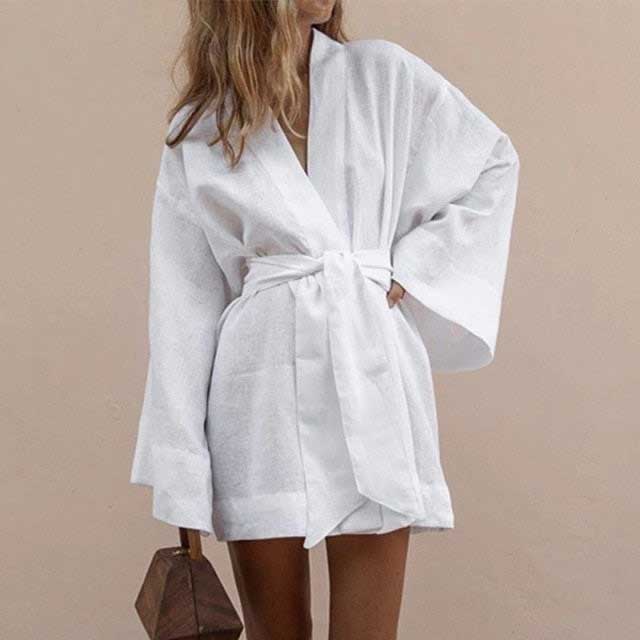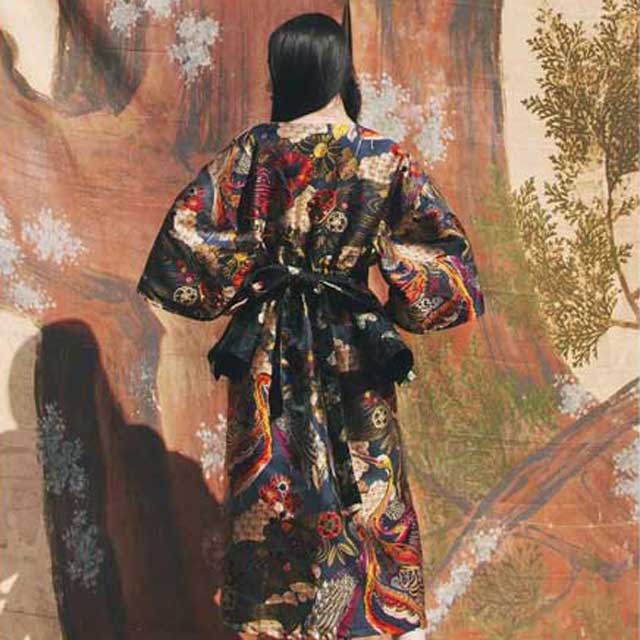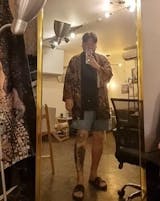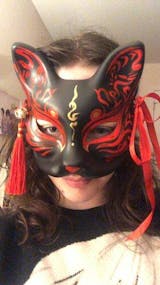Throughout Japan's rich and interesting history, the kimono has been a constant source of attention. It is a dress that often resembles a robe and has a unique structure. The Japanese wore separate upper and lower garments and numerous variations before they settled on a kimono as their most-worn clothing. It is also true that the kimono we see in Japan today varies greatly from the original garment. The kimono has transformed into casual styles such as the 'Yukata,' but it is regarded with extreme respect in all of Japan.
What is a Kimono?
Kimono is the Japanese word for 'clothing,' although it is entirely used to refer to one specific garment. The Japanese wear this semi-dress robe at their most significant cultural and religious events, as the dress has been a part of their lifestyle for several centuries. This dress was created in the Heian period and still holds a permanent spot in Japanese culture. Although some kimonos can be used as casual clothing, most are beautiful dresses made from silk and printed cotton. The kimono colors are also bright and represent ideas such as good fortune and success.
Kimono dresses for women are usually floor-length and have exaggerated skirts made from stiff materials. This design makes the garment look graceful, especially for women. It should also be noted that kimonos have several layers and underclothes that are a part of the dress, and the garment can not look complete without them. The layers are similar to the outer skirt and may be stitched from polyester or linen. Of course, in hotter weather, these layers can be removed in favor of cotton kimonos known as Yukatas. In older times, the decorations and colors of a kimono were not considered vital to the outfit. However, the patterns and printing on a kimono dress are very significant in modern Japan. This is one of the reasons why full kimono sets are so costly to prepare and buy.
History Behind the Kimono
The first kimono was nothing like the dignified and lovely garment we see today. It was made from two pieces of cloth, and they were stitched together randomly to form a dress. The earlier kimonos were designed to fit people of all body types and sizes. People belonging to this period were only interested in creating a modest and comfortable piece of clothing for everyday use. After the Edo period of the 17th century, the kimono developed into a formal dress. The term kimono was not figurated yet, and newer dress versions often only had small sleeves and irregular stitching.
During the Edo era, the kimono served as a unifying piece in Japan as every person, regardless of caste, age, and gender was required to wear it. Visitors from other nations could recognize a Japanese individual from afar simply by assessing the kimono. It should also be noted that although every citizen wore the kimono, the colors, textures, and designs of their garments indicated their status in society. Japan's low-income classes had to live with poorly-stitched kimonos, and they were often in an undesirable state. However, the richer classes could afford to buy newer and fancier kimonos whenever they wished. Their garments were more refined and artistic, showing off their wealth.
How do you wear a Kimono?
The kimono is a culturally and historically important dress to the Japanese, so any tourists wanting to wear it must follow certain rules. For one, the left side of the kimono dress should always overlap the right. It would seem disrespectful if you have the right side over the left of your nagajuban, as that practice is reserved for only the dead. In addition to this, keep in mind the variations that you have to follow according to your gender and age. For example, the collar of a kimono is almost always round and wide for younger women. However, older women show off less of their necks, and their collars are stiff and upright.
It is nothing to be ashamed about if you need a professional to help you assemble your kimono. The dress is a complex piece and will only look its best if you are aided by someone who knows what they are doing. The nagajuban is an undershirt that you wear to protect your kimono from any sweat or bodily odor. Most kimonos are expensive and precious garments, so it makes sense to do the utmost to preserve them. Over the nagajuban comes the kimono, and to fasten these two together is the Obi belt. This belt acts as a corset and helps tidy up the kimono's excess cloth. Your waist is kept upright, and the Obi also helps with your posture. Some women may tie their kimono with a koshihimo, an under belt that is not seen under the Obi. This is usually done in festive kimonos, where the Obis are merely a decorative element.
What Does a Kimono Dress Represent?
As mentioned earlier, the kimono is usually decorated with various dyes, decorations, and prints. Kimonos made for special occasions may also be embroidered with gold or silver thread to uplift the dress. Most kimonos are decorated around the sleeves and hems, and the upper part of the dress is left bare to showcase the color schemes. When painting and coloring the kimono became a common practice, Japanese designers started paying more attention to which colors suited the fabrics. There is a great deal of skill involved in deciding the ornaments and patterns that need to go over a kimono, as the age and gender of the wearer must be kept in mind.
Kimono dresses for women often include paintings of the Plumtree. The plum tree blossoms between two seasons, spring and winter. Therefore, it is seen as a symbol of preservation and hope. Plums are culturally significant to Japan, and cherry blossom flowers are known as Sakura. Older women in Japan are particularly fond of cherry blossoms on their kimonos, as they signify beauty and rebirth, especially the transition of moving between stages of life. Cherry blossoms stand out on any colored kimono, which is why they are a huge favorite. These flowers are usually printed on kimonos with a dark-colored skirt as the flowers themselves are pale pink and white.
The Matsu, also known as the pine tree, is a popular image to print over kimonos. Every kimono-making business has its way of designing and painting its garments. The most common method is using stencils. If a customer wants pine trees on their kimono, the designer will start with a small stencil and move it over the sleeves and hem of the dress. Eventually, they will paint bigger pine trees by hand to create a pattern. There is no definite rule for painting and coloring a kimono, although some methods like stencils and sketching are considered classic and favored.
How to Complete Your Kimono Outfit
When you wear a garment as historical and traditional as the kimono, it is fitting that you also wear the special footwear that comes with it. The Japanese also have unique split-toed socks called Tabi made from white cotton. Although Tabi can be colored, it is always best to wear them white. With these socks, you can either wear the zori or the geta. Zori is cultural sandals made from straw that look beautiful with tabi socks. Some zori can be made of vinyl or fabric, depending on the formality of the event. The most formal zori are covered with brocade, and they must be worn at the most special ceremonies after these come to the vinyl and straw zori.
Geta are wooden sandals that resemble flip flops. These sandals are often elevated and lift you off the ground with either wooden supports or teeth. They are highly comfortable but are not worn as much as zori these days. Geta are reserved for theatre performances of traditional displays in Japan. However, that should not stop you from getting yourself a pair and accessorizing it with your kimono! For men, the zori is never informal, and they can wear the straw one for all events. They can also wear zori without the tabi socks if they go somewhere informal.
How do you Accessorize a Kimono?
Kimono dresses are unlike any other traditional garments. Foreign visitors in Japan usually rent their kimonos as they can be quite expensive to purchase entirely. The kimono is an asymmetrical garment that must make the wearer look modest and charming. It is sometimes needed to wear slight padding underneath your kimono so your posture can remain straight while moving around. The kimono hem should also be parallel to the ground so the entire dress can resemble a tube. It might sound uncomplicated, but most beginners do not achieve this feat without some extra help the first few times.
Once you have succeeded in wearing your kimono, it is time to move over to accessorizing it. The Obi belt itself is a major accessory, and most formal kimonos have a silk Obi in bright, beautiful colors. This is because the Obi is the most eye-catching part of the dress, and it should always be stiff as it has to uphold the entire kimono. Even if the rest of the kimono is plain or scarcely printed, the Obi must be fashionable and striking in its appearance.
For women, accessorizing a kimono can be unimaginably fun as there are endless possibilities. The kanzashi hair accessories are quite common among younger Japanese women, and they include hairpins, flowers, or other small ornaments that you fasten in your hair. Unsurprisingly, a cherry blossom hairpin is a favorite as it is mostly made from silk and dyed a pale pink, which looks delightful over dark hair. Your hairpins can also include small gemstones and pearls if you are dressing for a festive event. Bejeweled accessories usually look best with luxury kimonos.
When Should You Wear a Kimono?
The kimono is an essential garment in Japan's culture, which is why the citizens still honor it. They choose to wear the kimono at their most significant events and not traditional Western dresses. Although the dress is very symbolic throughout Japan, the people do not wear it every day and instead reserve it for their special events, which adds to the value of the garment. If you are a tourist in Japan, it is important to know which occasions require you to wear or rent a kimono.
The dress represents good fortune and new beginnings, and it is seen as a good gesture for someone to wear the kimono out of respect if they are visiting Japan for the first time. If you want to wear the kimono informally, look for a yukata usually worn in the summer and made of cotton. Yukatas are cheaper so you can buy one specially tailored for yourself and take it to your home country! The younger generation in Japan tends to favor Western clothing over traditional kimonos as they are not too practical for everyday life. However, this does not mean that the garment is going out of style, and kimonos are still popular among the older generation. Before selecting a yukata or kimono, it is best to try it on and walk around in it to see if you are comfortable.
Graduation ceremonies in Japan are considered traditional formal events, and most girls wear their best kimonos to these gatherings. Recently, male students have joined in on the trend, and the number of people wearing the kimono increased. Another event you must wear a kimono to is a traditional Japanese wedding. The groom will usually wear a boldly colored kimono in black, while the bride can wear two kimonos. One is in white to symbolize purity and innocence, and the other is a red overcoat usually designed beautifully to enhance the bride's features. Guests at a Japanese wedding should wear subtle and modest kimonos to avoid the couple's attention.











